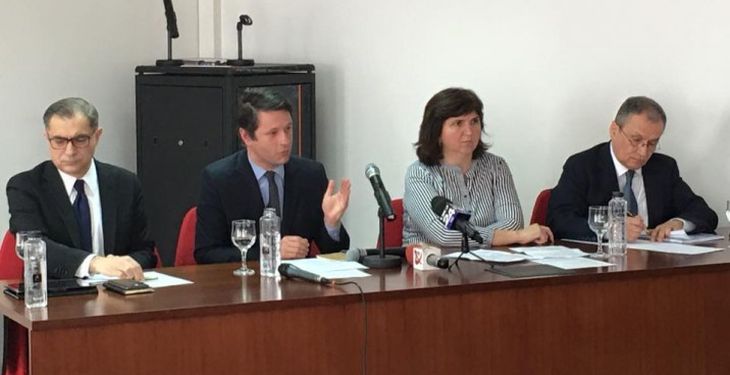Daniel Apostol
General Secretary of ROPEPCA
I recently participated (Monday, March 21st) in a debate – another one – regarding Romania’s energy strategy for the period 2016-2030, with perspectives for 2050. In the multitude of debates, round tables, conferences and events that question the Romanian energy sector, its present and its future, another meeting upon this subject might seem unnecessary. But not really. This time, the debate entitled “Analysis of the current status – radiography for the national energy system and a base for the development of the new energy strategy” seemed quite offering to me, knowing the seriousness and professionalism of its initiator and moderator, Radu Dudău, an expert from the field and coordinator of the group for the strategy development. The debate was hosted by the Polytechnic University of Bucharest and was attended by Minister of Energy Victor Grigorescu, the Ambassador with special assignments for energy security Mihnea Constantinescu, Vasile Iuga, the Secretary of State for Energy Corina Popescu. From the outset, Minister Grigorescu explained that we are in the evaluation phase of the system status, because Romania seems to be far from what it wants to be really, namely a security supplier in Central and South East Europe.
I expressed at the debate, a point of view that I will resume here: Romania is on the world map in a point that often many people (experts, analysts, politicians, journalists, strategists, military etc.) consider to be a knot, a place where they could create things, policies, strategies, developments, conflicts etc. I see this “knot” with at least two different meanings, two possible interpretations. The first would be that a “knot” on the world map is a place where transcontinental energy interests converge, a point which would bring together the ways of energy transportation, the communication channels and the Asian, European, North African trade routes. Such a “knot” would be a required station for a new “Silk Road” that would carry energy in its various forms, energy and financial resources and the latest technologies, from East to West (especially the first category, natural and energy resources) and from West to East (especially money, financial instruments and advanced technologies).
A second possible interpretation of the “knot” is that it would be the point on the world map in which the energy, political, economic, diplomatic, military interests are knotted, entangled, met, around the transfer of the resources enumerated above. But, in my view, this is where we must realize who we really are objectively and what we intend to be. A strategy – be it for energy – of a nation must clearly state who we are and where we want to go, but clearer than this must be the statement throughout which the main resources and time that it takes to get from where we are what we want to be are identified. We need to eliminate the risk of being the “knot” that drives away the common interests and cross-border projects. We must avoid to “knot” the clear, straight and soft lines, and to continue to attract major investment projects, with huge impact on our society and especially for the next 20-30 years thereof. We must realize that the energy sector is intensive in terms of investment, requires investments of high value, high volume, long service life, economic scale, investments that bears the feature of considerable economic multiplier. An example is the study made by KPMG for ROPEPCA (The Romanian Oil Production and Exploration Companies Association) which stresses out that each euro invested in Romania by the oil and gas has produced nearly four times much more economic effect on horizontal. For an euro invested, we find 3.5 euros produced in the domestic economy (I will return with an elaborate answer about this study in a future material, interested readers can find it next week on www.ropepca.ro).
Therefore, I believe that the state has a major role in the break up, the unknoting of things, to lift barriers for investments that need to be attracted and encouraged to have in Romania a foothold or, rather, a hub (we go back to the “knot”, this time with a positive significance) on the world energy map. How the state judges the context of international developments in the energy markets, the interests of cross-border investment projects and how the state thinks, develops and applies the laws and regulations impacting the energy sector will show what kind of “knot” wants the state for Romania to become.
I loved that, in the previously announced debate, the statement of the Ambassador Mihnea Constantinescu: he warned that Romania must have and has to develop a strong technological ambition, a vision of technological innovation, an approach of technological frontier in the energy sector. Without a serious injection of technological innovation, the Romanian energy sector is likely to lag behind European competitiveness, will become a gray area on the world map. At the same time, there must be a serious debate about financing the energy sector, at a time when there is a clear inventory of financing instruments linked between government ministries, banks, investment funds, private investors, European funds. It takes solid financial instruments to finance the energy sector, Mihnea Constantinescu concluded.
But suddenly, from the audience broke out a voice: “So what is the news?”. The question – a natural one, I say – of a television reporter actually emphasized the need to observe, not just the statements of good intentions, but rather the facts, developments, results. The news, I would say, must come. The news will not be reading itself, in public, of the energy strategy. The news will be the begining of putting it into action.
